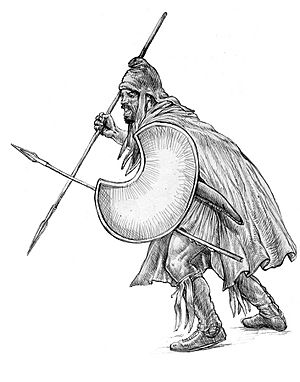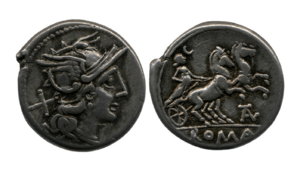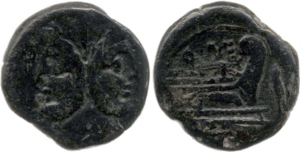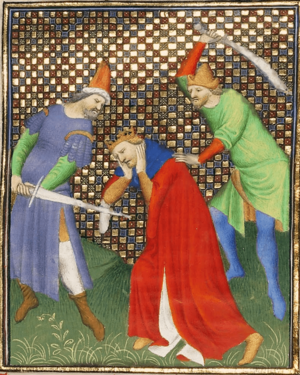Fourth Macedonian War facts for kids
Quick facts for kids Fourth Macedonian War |
|||||||||
|---|---|---|---|---|---|---|---|---|---|
| Part of Macedonian Wars | |||||||||
 A coin of Andriscus, made over a Roman coin. It might have been taken as a prize after Andriscus' first victory. |
|||||||||
|
|||||||||
| Belligerents | |||||||||
| Roman Republic Attalid kingdom Achaean League |
Macedon Thracian allies Carthage |
||||||||
| Commanders and leaders | |||||||||
| P. Cornelius Scipio Nasica Publius Juventius Thalna † Quintus Caecilius Metellus |
Andriscus Teres III Barsabas |
||||||||
The Fourth Macedonian War (150–148 BC) was a conflict between Macedon, led by a man named Andriscus, and the powerful Roman Republic. It was the final war in a series called the Macedonian Wars. This war was the last time Roman control over Greece was seriously threatened for many years.
The last king of Macedon, Perseus, had been defeated by the Romans in the Third Macedonian War in 168 BC. After that war, Rome took control of the region indirectly. They set up smaller, weaker states that had to follow Rome's rules. This plan worked for almost 20 years. But then, Andriscus, a Greek man who looked like King Perseus, claimed to be Perseus's son. He gathered an army of Thracian soldiers and brought back the Macedonian Kingdom.
Andriscus had early success. He defeated Roman allies and even a Roman army. He also conquered a large area called Thessaly. However, he was eventually defeated by another Roman army. This army was led by Quintus Caecilius Metellus at the Second Battle of Pydna in 148 BC. This loss greatly weakened Andriscus. He was later captured and handed over to the Romans. After a few smaller rebellions, Rome took direct control of Macedon. They made it a Roman province, which meant it was now a part of the Roman Empire.
Contents
Why the War Started
Tensions between the Roman Republic and Macedon began way back in 215 BC. At that time, Philip V of Macedon joined forces with Rome's enemy, Carthage. This started the First Macedonian War. Later, Rome won its war against Carthage. Many Greek cities then asked Rome for help because they feared Philip's growing power. Rome agreed to help. They defeated Philip in the Second Macedonian War (200-197 BC). Philip lost much land and power.
After this, Rome also fought the Seleucid Empire. This empire was led by Antiochus III the Great, who wanted to control Greece. Rome won the Roman-Seleucid War (192 BC). Antiochus lost all his land in Asia Minor. Macedon gained some land for helping Rome. But Rome's actions still caused anger in Philip.
Macedonian power grew again under Philip's son, Perseus. Rome and Perseus were officially "friends," but tensions rose. Perseus became popular with the Greeks. He made Macedon a strong power once more. In 172 BC, Eumenes II of Pergamon, a Roman ally, convinced Rome that Perseus was a threat. An attempt to kill Eumenes, blamed on Perseus, finally led to war. The Third Macedonian War (171-168 BC) was tough. But Rome won completely. Perseus surrendered and was imprisoned. This made Rome the most powerful force in the Greek world.
After Rome's victory, the Greek world was treated harshly. Allies of Perseus were punished. Rome took strong steps to prevent Macedon from rising again. The old Macedonian monarchy was ended. Perseus was sent away to an Italian city. Rome did not want to make Macedon a province right away. This was because it would need soldiers to protect against barbarian tribes in the north. Instead, Macedon was split into four separate "client republics." These republics paid taxes to Rome. They had rules about trade and could not easily interact with each other. They also could not freely use Macedon's rich mines. They could only have small armies to fight northern tribes. Most of the old Macedonian leaders were sent to Rome. Macedon also became poor. This was due to the new rules and Roman soldiers taking treasures. This, along with the destruction of the old social system, made many people angry.
However, Rome pulled all its troops out in 167 BC. After that, Rome let the Macedonian republics manage themselves. They did not even step in when there were serious problems. Some rules were relaxed. For example, Macedonians could use their mines again from 158 BC. But anger remained over the remaining rules and the division of Macedon. This situation was perfect for someone to claim the old Macedonian throne.
Andriscus Claims to Be King

Around 154/153 BC, a Greek man named Andriscus appeared. He looked like the old Macedonian kings. He claimed to be Philip, a forgotten son of King Perseus. He said he had been raised secretly by another family. His background is not clear. Ancient writers usually say he came from a humble family. He was from Adramyttium in Asia Minor. He first tried to enter Macedon with force to claim his "throne." But he was pushed back. This was probably by the armies of three of the four republics.
After this failure, he went to Syria. He became a soldier for the Seleucid king, Demetrius I Soter. There, he started making his claims again. News of his claims spread. He asked King Demetrius I for help to get his throne back. Even though many people in the Seleucid capital, Antioch, supported him, Demetrius refused. Instead, Demetrius arrested Andriscus and sent him to Rome. The Roman Senate was not worried. They simply sent him away to an Italian city. But Andriscus soon escaped from Italy. He went back to the Greek world. The Romans still did not take him seriously.
He traveled to Miletus, where he kept trying to gain support. He got a lot of attention. Diodorus, an ancient writer, says that the leaders of Miletus arrested him. They asked Roman officials what to do. The Romans did not care about Andriscus. They told the Milesians it was safe to let him go. After his release, he kept trying to become king of Macedon. He went to Pergamon. There, he met Callippa, a former partner of King Perseus. She gave him money and royal clothes. From there, he went to Byzantium. He was welcomed there and gained many followers. Some historians think his followers were Macedonians who had fled after the Third Macedonian War.
Andriscus then went to Thrace. He found allies and support there. Especially from the Odrysian king Teres III. Teres was related to the old Macedonian kings by marriage. Teres held a ceremony to crown Andriscus. He gave him a royal diadem and 100 soldiers. He also introduced him to other Thracian leaders, like Barsabas. Barsabas agreed to join Andriscus's fight to reclaim the Macedonian throne. Andriscus also got help from some Macedonian groups who had left their homeland.
The War Begins
Andriscus Takes Control
With his new army, Andriscus invaded Macedonia in the spring of 149 BC. At first, he did not get much support from the Macedonian people. This made the Roman client republics in Macedon feel confident. The Roman Senate also felt relaxed about the threat. There are signs that his first attempts to conquer Macedon failed. But he gathered his forces and tried again. He fought one of the republics near the Strymon river. He won a big victory. He then conquered all of Macedonia west of the Strymon. This included the old royal capital of Pella. He made Pella his home around the summer of 149 BC. At this point, he took the royal name Philip. The Macedonian republics to the west kept fighting him. But they were defeated in another battle. After that, the Macedonians seemed to accept him as their king.
His victories earned him the loyalty of the Macedonians. The people wanted a king again. They were ready to accept a ruler. They also wanted to get rid of the artificial divisions and fighting among the client republics. The neighboring Greeks, including the historian Polybius, were surprised. Polybius wrote how amazed he was that this pretender, who "dropped from the skies," could be accepted so eagerly by the Macedonians. Andriscus then attacked Thessaly. The Thessalian League asked the Achaean League for help. They knew Rome would be slow to get involved. These Greek forces and the remaining pro-Roman Macedonians fought Andriscus for some time. Finally, Rome decided to send a leader, Scipio Nasica Corculum, to see what was happening.
Rome Gets Involved
Scipio was sent to try and make a peaceful agreement. Some historians say Rome might not have understood how serious the situation was. Or they might not have been fully committed to their earlier peace plan. It is also possible he was sent before news of Andriscus's victories spread. He might have been sent to stop Greek support for Carthage, which Rome planned to attack. Whatever the reason, Scipio's peace talks failed. This was probably because Rome would not accept Andriscus as king of a united Macedon. Instead, Scipio used military action. He gathered the Thessalian and Achaean forces that were already fighting. With them, he managed to stop Andriscus's advance for a short time. Still, the Roman commander told the Senate that direct military action was needed. The situation was getting bad, and Andriscus had already conquered much of Thessaly.
Thalna's Defeat
In response to Scipio's report, the Roman Senate appointed a praetor (a Roman official), Publius Juventius Thalna. He was given command of a legion (a large army unit) to solve the problem by force. Thalna probably got more help from Greek soldiers. He spent two or three months making the situation stable. But he seemed to underestimate Andriscus. He did not realize that Andriscus's army had grown a lot. It now included both Macedonians and Thracians. Thalna tried to invade Macedonia through Thessaly. Andriscus stopped him near the Macedonian border in late 149 or early 148 BC. Details of the battle are few. But Thalna was killed, and his army was almost completely destroyed. The few survivors escaped in the dark. This was the worst defeat Rome had suffered against a Hellenistic (Greek-influenced) power. It had a huge impact in both Greece and Rome.
In Macedon, Andriscus's popularity grew greatly. He launched another invasion of Thessaly. He successfully conquered and damaged most of it. Other countries became more interested in him. Carthage, which was fighting Rome in the Third Punic War, agreed to an alliance with him. They promised him money and ships. On the other hand, Attalus II Philadelphus of Pergamon remained a strong Roman ally. He did not want to see a strong Macedon as his neighbor. The battle also showed that the Macedonians were committed to their new monarchy.
At the same time, the Macedonian victory meant no more hope for peace with Rome. The Romans could not accept such a defeat. They decided to crush Macedon's power once and for all. Fears of Roman revenge caused some people in Macedon to switch sides. Andriscus began to act harshly against anyone who supported Rome. He used terror and force against them.
Metellus's Campaign
Rome soon began preparing a full army of two legions for Macedon. It was hard to raise such a force. Rome already had many legions fighting in other wars. But the Senate did not want to take any risks after Thalna's defeat. They really wanted to avoid Macedon and Carthage working together. Both Roman consuls (top officials) for that year were already fighting elsewhere. So, the Senate gave the campaign to one of the year's praetors, Quintus Caecilius Metellus. They gave him special powers like a consul.
Metellus arrived in Greece in the summer of 148 BC. He got help from the fleet of Attalus II. He advanced along the coast of Thessaly. The Pergamene fleet threatened the coastal areas of northern Macedonia. Amphipolis seemed to be out of Andriscus's control by this time. To protect himself from both attacks, Andriscus took a defensive position at Pydna. There, the Roman commander fought him in battle.
The Second Battle of Pydna
Not many details are known about this battle. We do not know the exact number of soldiers. The first fight was a cavalry skirmish (a small fight between horsemen). Andriscus's forces won this, defeating some Roman cavalry. Before or around this time, a Macedonian cavalry commander named Telestes left Andriscus. He took a large part of the Macedonian cavalry with him.
After this, Andriscus sent some of his forces away. He might have done this to continue his campaign in Thessaly. Or maybe he had supply problems. Or he might have been too confident. Metellus took this chance to attack with his full strength. He might have had help from traitors in Andriscus's army. His forces quickly defeated both parts of Andriscus's army. Andriscus himself fled the battle.
The War Ends
The battle destroyed Andriscus's army. It broke the Macedonian war effort. He fled to Thrace and began raising another army there. But Metellus quickly followed him. He forced Andriscus into a new battle before his new soldiers were ready. This fight was an easy victory for the Romans. As soon as the Macedonian front lines broke, the rest of the army ran away in panic. Andriscus himself fled to a Thracian prince named Byzes. But Metellus convinced Byzes to become a Roman ally and hand Andriscus over. This ended the main campaign.
However, Macedon was not fully peaceful yet. Another uprising, probably with Thracian help, started. It was led by a man named Alexander. He claimed to be a son of Perseus. He took control of the Nestus River area. But Metellus quickly defeated him. Alexander was forced to flee into Dardania. By the end of 147 BC, Metellus had mostly calmed the country and brought back order. This was not the last time Macedon rebelled against Rome. Another pretender caused a serious problem in 143/142 BC. He raised an army of 16,000 men. But he was defeated and killed by a Roman official named Lucius Tremellius. Also, border problems with the Thracians continued.
Metellus punished the Macedonians. He also punished the Byzantines, who had supported Andriscus. He took a lot of treasure. This included some spoils taken by Alexander the Great at the Battle of the Granicus. He also took many valuable artworks. After settling affairs in Greece and Macedon, Metellus returned to Rome in 146 BC. He was given the special name Macedonicus (meaning "conqueror of Macedon"). He also received a triumph, a parade to celebrate his victory. Andriscus was paraded in this triumph and then executed.
Rome Changes Macedon
The Roman Senate realized that their old system for Macedon could not last. The support Andriscus's uprising gained showed that indirect control was weak. It also showed the need for a complete change in Macedon. It is likely that Roman officials were sent to Macedon soon after Metellus's victory. They, along with Metellus, made changes to how Macedon was governed. They gave many important jobs to a Roman praetor. From this point on, a Roman legion and a praetor were always stationed in Macedon. This was the first time Roman troops were permanently based east of the Adriatic sea. Macedon was united into one administrative unit called the Provincia Macedonia. The new province included not only Macedon, but also parts of southern Illyria, Epirus, and Thessaly. This had mixed reactions. On one hand, people welcomed the reunification of Macedon. On the other hand, they resented losing their freedom and facing harsher Roman rule. Many praetors would be corrupt and demand too much. Also, they were not as good as earlier governments at protecting the region from barbarian raids.
The exact details of when Macedon became a province are still debated. A new "Macedonian Era" was announced in 148 BC. But it is argued whether this marked the province's formation or Metellus's victory. Some doubt if Metellus had time to organize Macedon into a province. They suggest it was one of the consuls of 146 BC, Lucius Mummius, who reorganized Macedon. He might have done this with the help of a special commission while settling affairs in Greece. Some historians doubt if Macedon ever formally became a province. They point out that the Macedonian "merides" (divisions) continued to exist for a long time. In their view, what changed after the Fourth Macedonian War was that a Roman praetor and his legion were always in Macedonia. Naturally, they slowly took on more administrative roles. This led to an informal provincialization. Still, the presence of Roman officials after 148 BC was a clear change. It meant the loss of Macedonian and Illyrian freedom.
What Happened Next
Soon after, in 146 BC, the Achaean League started a new war against the Roman Republic. This is known as the Achaean War. It was short and happened right after Macedon fell. Until this time, Rome had only fought in Greece against Macedonian forces or their allies. The Achaean leaders almost certainly knew that declaring war on Rome was hopeless. Rome had won against much stronger enemies. The Roman legion had proven better than the Macedonian phalanx.
The historian Polybius blames the popular leaders of the Achaean cities. He says they inspired the people into a destructive war. Ideas of Greek unity and triumphing against big odds motivated the league. The Achaean League was quickly defeated. As a lesson, Rome completely destroyed the city of Corinth in 146 BC. This was the same year Carthage was destroyed. For almost a century, Rome had dealt with constant problems in the Greek world. These problems always led back to internal instability and war when Rome left. So, the Senate decided to establish the Roman province of Macedonia. This province covered all of mainland Greece. It created a permanent Roman presence in the region. However, a few areas like Athens and Sparta kept some self-government. More than a century later, Augustus would create Achaea as a separate province.
See also





